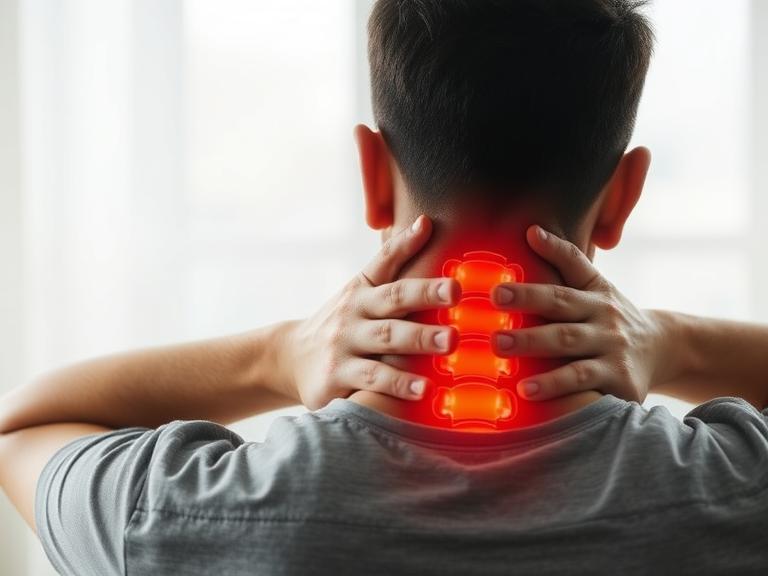Neck discomfort is one of the most common health problems today, often overlooked until it starts interfering with daily life. Known medically as cervical pain, this condition originates from the cervical spine, the part of the spine located in the neck. From minor stiffness to severe nerve compression, cervical pain symptoms can range widely and significantly affect quality of life.
In this blog, we will unlock the mystery of cervical pain—exploring what it is, why it happens, its worst manifestations, and effective cervical pain treatment strategies for lasting cervical pain relief.

What Is Cervical Pain?
Cervical pain refers to discomfort, stiffness, or sharp pain felt in the neck region, also known as the cervical pain area. It may be localized or radiate to the shoulders, arms, or back. While occasional neck stiffness may not be alarming, persistent or worsening cervical pain symptoms can indicate underlying conditions such as cervical spondylosis, herniated discs, or nerve compression.
Anatomy of the Cervical Spine
Understanding the structure of the cervical spine is essential to grasp why cervical pain occurs.
- The cervical spine consists of 7 vertebrae (C1–C7).
- It supports the head’s weight (10–12 pounds).
- It enables head movements like nodding, turning, and tilting.
- It protects the spinal cord and nerve pathways.
Any injury, strain, or degeneration in this region can lead to significant cervical pain symptoms.
Common Causes of Cervical Pain
1. Poor Posture
Modern lifestyle habits like looking down at smartphones or slouching while working contribute significantly to cervical pain.
2. Muscle Strain
Sudden neck movements or sleeping in awkward positions can strain muscles, causing sharp cervical pain.
3. Cervical Spondylosis
Age-related degeneration of discs and joints in the cervical spine leads to chronic cervical pain symptoms.
4. Herniated Discs
When discs bulge or rupture, they press on nerves, resulting in severe cervical pain and tingling sensations in arms.
5. Injuries (Whiplash)
Accidents can cause ligament or muscle damage in the cervical pain area, leading to prolonged discomfort.
6. Stress and Tension
Emotional stress can cause muscle tightness in the neck, worsening cervical pain symptoms.
Worst Cervical Pain Symptoms You Shouldn’t Ignore
- Chronic stiffness and reduced flexibility
- Shooting pain radiating to shoulders and arms
- Tingling, numbness, or weakness in fingers
- Headaches starting at the base of the skull
- Dizziness or balance issues
- Trouble sleeping due to cervical pain
If these cervical pain symptoms persist, immediate medical evaluation is crucial.
Diagnosis of Cervical Pain
Doctors use several tests to identify the cause of cervical pain symptoms:
- X-rays – Detect bone degeneration.
- MRI scans – Show disc and nerve issues.
- CT scans – Provide detailed bone images.
- Electromyography (EMG) – Tests nerve activity.
Cervical Pain Treatment Options
1. Medications
- Pain relievers (acetaminophen, NSAIDs)
- Muscle relaxants
- Corticosteroid injections for severe cervical pain symptoms
2. Physiotherapy
- Posture correction
- Neck-strengthening exercises
- Stretching routines for cervical pain relief
3. Lifestyle Changes
- Ergonomic workstations
- Supportive pillows for proper sleep posture
- Regular breaks during desk work
4. Surgical Treatments
When conservative cervical pain treatment fails, surgery may be needed for herniated discs or spinal cord compression.
Home Remedies for Cervical Pain Relief
- Hot and Cold Therapy – Reduces swelling and relaxes muscles.
- Gentle Neck Exercises – Improves flexibility.
- Massage Therapy – Eases tension in the cervical pain area.
- Yoga and Stretching – Keeps the cervical spine flexible.
- Stress Management – Meditation and deep breathing reduce neck tension.
Exercises for Cervical Pain Relief
- Chin Tucks – Keep your spine aligned.
- Neck Rotations – Slowly rotate head left to right.
- Side Neck Stretch – Tilt head gently to each side.
- Shoulder Shrugs – Relieve tension in upper back.
- Cat-Cow Stretch – Enhances flexibility of spine.
These movements, when done daily, help prevent recurrence of cervical pain symptoms.
Preventing Cervical Pain in Daily Life
- Maintain correct posture while working.
- Keep computer screens at eye level.
- Limit mobile phone screen time.
- Stay physically active with stretching and exercise.
- Use ergonomic chairs and firm mattresses.
Emotional and Lifestyle Impact of Cervical Pain
Living with chronic cervical pain symptoms can be exhausting. Persistent discomfort often leads to irritability, poor concentration, and even depression. By addressing cervical pain treatment early, people can prevent emotional burnout and maintain a healthy lifestyle.
When to Seek Urgent Help for Cervical Pain
See a doctor immediately if you experience:
- Sudden weakness in arms or legs
- Loss of bladder or bowel control
- Severe, unexplained cervical pain symptoms after injury
- Persistent dizziness with neck pain
Final Thoughts
The truth about cervical pain is that while it’s common, it should never be ignored. From posture-related discomfort to severe degenerative conditions, the cervical pain area requires careful attention.
Early recognition of cervical pain symptoms, adopting healthy lifestyle changes, and timely cervical pain treatment can ensure long-term cervical pain relief and improved quality of life. By unlocking the mystery behind cervical pain, we can take steps to prevent it from becoming a life-limiting condition.



